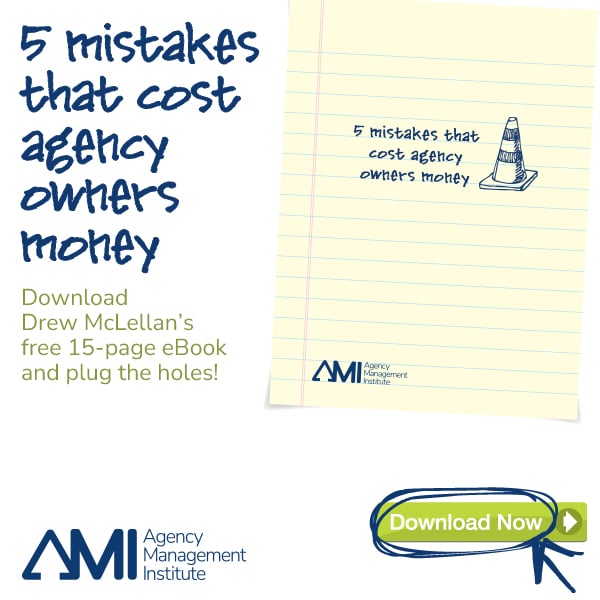In old cartoons and action movies, the idea of self-destruction usually involved a giant red “self-destruct” button, just waiting to be pushed to trigger an explosion of impending doom. When pressed, it initiated a countdown, and the characters scrambled to get away before they were engulfed in flames. In agency life, self-destruction sneaks up on agencies struggling to maintain their own new business pipelines while serving their clients. But, if left unattended, it can have equally catastrophic results.
Client Work Comes First
Typically, agencies are brilliant at creating strong brands, grabbing an audience’s attention, and generating leads for the clients they serve. On a daily basis, they help these clients convert leads into customers and turn those customers into loyal, frequent buyers.
Sadly, when agencies spend the day helping their clients build their businesses, they tend to neglect their own lead gen and new business needs.
Agency Needs Aren’t Met With Urgency
Agency life is driven by deadlines and client needs. Employees spend their days putting out fires: shifted deadlines, PR crises, and customer complaints over social media.
Unfortunately, this same sense of urgency isn’t present when it comes to doing work on their agency’s behalf. Client deadlines (and billable hours) often win out over a few hours spent focusing on internal growth.
The Vicious Stop-and-Start of Business Development
This cycle of self-neglect often continues until an agency loses a big account or some other crisis strikes. Suddenly, it doesn’t have enough business to sustain itself and faces layoffs or other drastic measures.
Only then do agencies typically gear up the new business machine, using the tactics they preach to their clients every day. But as soon as they get busy with client work again, these new business efforts stall.
Not only is this cycle wearing, but it’s also unsustainable in the long term. Since the recession, the agency sales cycle has gotten longer and tougher. The process for engaging a new client can take six to nine months — a span most cannot survive.
Walking a Dangerous Road
Each time an agency waffles on its commitment to new business, it takes one step further down the path to self-destruction.
- The agency wastes money. Agencies preach the power of consistent marketing to their clients, but their own stop-and-start model expends more resources for a lesser result. It’s much cheaper to keep someone’s attention until he’s ready to buy than to have to get his attention over and over.
- Uncertainty torments employees. When leadership allows the new business machine to start and stop, employees worry about job stability. No agency can afford to look like a risky place to work.
- The agency’s actions destroy credibility. Clients view their agency’s actions as best practices. If they see their advisors are acting against the advice they’re giving, it makes them question the agency’s counsel.
- Bad timing catches up to the agency. Eventually, agencies will get their timing wrong, and the consequences will be permanent. Waiting too long can lead to significant loss, the need to take out loans, or worse.
Stop the Cycle of Self-Destruction
A business that consistently barely scrapes by is neither profitable nor sustainable in the long term. The lean times chew up all the profits the good times have produced.
To stay ahead, a consistent approach to new business is key. It starts with a top-down valuation of new business as not only crucial to the agency, but as something for which every employee should feel responsible.
1. Start at the top. To know how to act in any job, employees look to their direct managers — and ultimately, the leaders — for an example. Leaders must make it clear that new business is critical to the agency’s success and instill a sense of ownership in each employee.
2. Have a plan. Agencies should not only carve out a niche of expertise within an industry, but they should also put together a marketing plan that emphasizes this point of differentiation (just as they would for their clients). A cohesive plan allows for a proactive allocation of time and resources for each tactic.
3. Provide outlets for everyone to get involved. Make it clear that everyone plays a part in new business. While junior-level employees may not be going to pitches, they should be expected to at least contribute a few non-billable hours to new business through developing case studies or drafting blog posts for the agency website to promote thought leadership.
4. Make it public. Agencies should publicly recognize successful efforts to acquire new business, keeping metrics top of mind. This could mean announcing at a staff meeting when a team is about to go to a pitch, celebrating when new business is won, and fostering healthy competition among other competing agencies. It’s important that each employee identifies with the agency and wants it to win.
With agencies, there’s no countdown to self-destruction. It happens not with a bang, but with a fizzle. That’s why it’s so crucial to consistently instill the value of new business and growth from the top on down to avoid unwittingly pressing that big red button.
This article was written by Drew McLellan and first published on LinkedIn.






